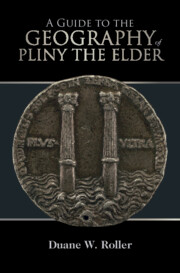Refine search
Actions for selected content:
23990 results in Ancient history

Housing in the Ancient Mediterranean World
- Material and Textual Approaches
-
- Published online:
- 08 July 2022
- Print publication:
- 21 July 2022

A Guide to the Geography of Pliny the Elder
-
- Published online:
- 07 July 2022
- Print publication:
- 28 July 2022
7 - The Path of Reverence
-
- Book:
- Hermetic Spirituality and the Historical Imagination
- Published online:
- 16 June 2022
- Print publication:
- 30 June 2022, pp 187-219
-
- Chapter
- Export citation
Appendix A - Xenophon’s Life and Times
-
- Book:
- Xenophon's Anabasis
- Published by:
- Edinburgh University Press
- Published online:
- 18 November 2022
- Print publication:
- 30 June 2022, pp 258-259
-
- Chapter
- Export citation
Conclusions: The Philosopher Unarmed
-
- Book:
- Xenophon's Anabasis
- Published by:
- Edinburgh University Press
- Published online:
- 18 November 2022
- Print publication:
- 30 June 2022, pp 245-257
-
- Chapter
- Export citation
Index of Subjects
-
- Book:
- Hermetic Spirituality and the Historical Imagination
- Published online:
- 16 June 2022
- Print publication:
- 30 June 2022, pp 428-438
-
- Chapter
- Export citation
Copyright page
-
- Book:
- Hermetic Spirituality and the Historical Imagination
- Published online:
- 16 June 2022
- Print publication:
- 30 June 2022, pp iv-iv
-
- Chapter
- Export citation
1 - Xenophon the Athenian
-
- Book:
- Xenophon's Anabasis
- Published by:
- Edinburgh University Press
- Published online:
- 18 November 2022
- Print publication:
- 30 June 2022, pp 10-46
-
- Chapter
- Export citation
4 - Children of Hermes
-
- Book:
- Hermetic Spirituality and the Historical Imagination
- Published online:
- 16 June 2022
- Print publication:
- 30 June 2022, pp 77-118
-
- Chapter
- Export citation
2 - Heart of Darkness
-
- Book:
- Hermetic Spirituality and the Historical Imagination
- Published online:
- 16 June 2022
- Print publication:
- 30 June 2022, pp 23-47
-
- Chapter
- Export citation
Introduction: The Philosopher Armed
-
- Book:
- Xenophon's Anabasis
- Published by:
- Edinburgh University Press
- Published online:
- 18 November 2022
- Print publication:
- 30 June 2022, pp 1-9
-
- Chapter
- Export citation
Abbreviations
-
- Book:
- Hermetic Spirituality and the Historical Imagination
- Published online:
- 16 June 2022
- Print publication:
- 30 June 2022, pp xiii-xvi
-
- Chapter
- Export citation
Appendix B - Xenophon’s Writings
-
- Book:
- Xenophon's Anabasis
- Published by:
- Edinburgh University Press
- Published online:
- 18 November 2022
- Print publication:
- 30 June 2022, pp 260-261
-
- Chapter
- Export citation
5 - Socrates in Anabasis
-
- Book:
- Xenophon's Anabasis
- Published by:
- Edinburgh University Press
- Published online:
- 18 November 2022
- Print publication:
- 30 June 2022, pp 185-244
-
- Chapter
- Export citation
Dedication
-
- Book:
- Hermetic Spirituality and the Historical Imagination
- Published online:
- 16 June 2022
- Print publication:
- 30 June 2022, pp v-vi
-
- Chapter
- Export citation
4 - Xenophon’s Self-Defence
-
- Book:
- Xenophon's Anabasis
- Published by:
- Edinburgh University Press
- Published online:
- 18 November 2022
- Print publication:
- 30 June 2022, pp 136-184
-
- Chapter
- Export citation
Bibliography
-
- Book:
- Xenophon's Anabasis
- Published by:
- Edinburgh University Press
- Published online:
- 18 November 2022
- Print publication:
- 30 June 2022, pp 262-280
-
- Chapter
- Export citation
3 - The Presence of Gods
-
- Book:
- Hermetic Spirituality and the Historical Imagination
- Published online:
- 16 June 2022
- Print publication:
- 30 June 2022, pp 48-76
-
- Chapter
- Export citation
Contents
-
- Book:
- Hermetic Spirituality and the Historical Imagination
- Published online:
- 16 June 2022
- Print publication:
- 30 June 2022, pp vii-viii
-
- Chapter
- Export citation
Acknowledgments
-
- Book:
- Hermetic Spirituality and the Historical Imagination
- Published online:
- 16 June 2022
- Print publication:
- 30 June 2022, pp ix-xii
-
- Chapter
- Export citation
